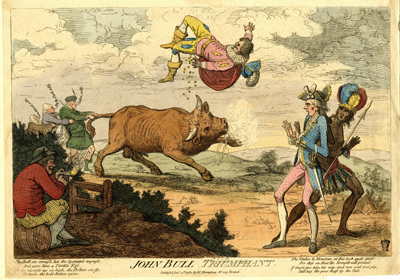John Bull Triumphant
The impetus for this striking and accomplished print by Gillray was the report of the battle of San Fernando de Omoa in which the British captured and (at least temporarily) held the Spanish fortress at Omoa in the Gulf of Honduras. In the process, they also took possession of two Spanish ships that had been anchored in the harbor loaded with more than 3 million Spanish silver dollars.

© Trustees of the British Museum
In June of 1779, Spain had joined France in support of America in her revolution against Britain, capturing in September both an English outpost at Baton Rouge and an English settlement on Saint George's Caye near Belize. An angry Britain retaliated with a successful land and sea attack on the fortress at Omoa in October. Holland, meanwhile, declared itself neutral, which meant, in practical terms, that it could watch from the sidelines and turn a healthy profit selling contraband goods and arms to all the participants in the conflict.
Like The State Tinkers, also produced in 1780, John Bull Triumphant is transitional in the developoment of Gillray's satire in using both emblematic and expressive techniques. Like a traditional emblem, the print consists of three parts: a title, an image, and an explanation.
As in an emblematic print, the figures and action portrayed in John Bull Triumphant are mostly symbolic. The bull is John Bull, the national symbol of Britain. The figure being tossed is Spain, using the stereotypical image for Spain common in prints by Gillray, Cruikshank. and others. It depicted Spain as a 17th century don with neck ruff, slashed doublet and breeches, and a plumed hat. The toss is, of course, the British attack on Omoa, and the coins raining from his pockets represent the millions of Spanish silver dollars captured by Britain in the attack. The Indian maiden is America, defended (not very well) by a fearful and effete-looking dandy representing France. And appropriately off to one side and out of immediate danger from the bull, a man with a Low Country cap and clay pipe sits upon a cask of "Hollands Gin." This is, of course, Holland.
An explanation is included below the image.
The Bull see enrag'd has the Spaniard engag'd,
And gave him a Terrible Toss,
As he mounts up on high, the Dollars see fly,
To make the bold Britton rejoice,
The Yankee & Monsieur, at this look quite queer,
For they see that his Strength will prevail,
If they'd give him his way, and not with foul play,
Still tug the poor Beast by the Tail.
The three men tugging on the tail are the Earl of Bute, Prime Minister Lord North, and former Lord Chancellor, William Murray. They are identified by their country seats, Luton, Bushey, and Kenwood respectively. The implication, perhaps, is that North and his advisors are inconsistent in their policy to the war, sometimes aggravating hostilities, and sometimes holding out a hope for peace and reconciliation.*
In typical emblem prints, the figures are usually wooden and characterless. Their symbolic value is all that matters. They are usually set against an almost blank or thoroughly unrealistic background. But here Gillray has done everything he can to make his figures seem alive and the background believable. The snorting bull is no mere symbol. It is beautifully drawn and completely expressive of the power that could launch a man, like our Spaniard, well into the air. France and America also display body language and emotions appropriate to real people not just national symbols. The Frenchman pulls back as he watches the raging bull get closer. The Indian maid looks up and back like she expects the flying Spaniard to land on her. The landscape with its hills and valleys, the sky and clouds, the foreground path, and the little hillock and brush where the Dutchman is lighting his pipe and enjoying the consternation created by John Bull—all of this is unnecessary to the meaning of the print, but indicative of the expressive and realistic artist in Gillray working side by side with the emblematic satirist.
Alas, the triumph of John Bull was short lived. By the time news of the capture reached England in early December, Omoa was already back in the hands of Spain (Nov. 29).
* A similar point is made by an anonymous caricaturist in the roughly contemporary print, The Bull Over-Drove; or the Drivers in Danger (February 21, 1780.
Sources and Reading
- Commentary from the British Museum on John Bull Triumphant.
- "Battle of San Fernando de Omoa," Wikipedia
- "William Murray, 1st Earl of Mansfield," Wikipedia
- "Frederick North, Lord North" Wikipedia
- "John Stuart, 3rd Earl of Bute," Wikipedia
- Thomas Wright and Joseph Grego, The Works of James Gillray, the Caricaturist; With the History of His Life and Times, p. 29-30.
Comments & Corrections
NOTE: Comments and/or corrections are always appreciated. To make that easier, I have included a form below that you can use. I promise never to share any of the info provided without your express permission.